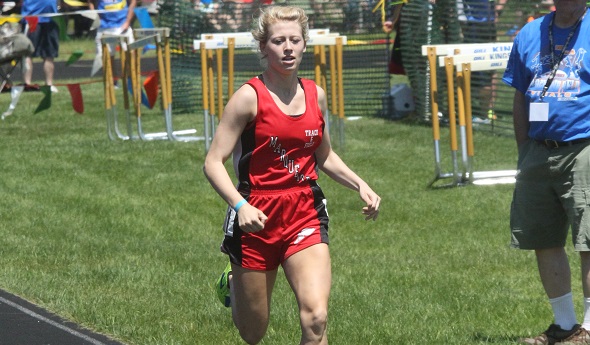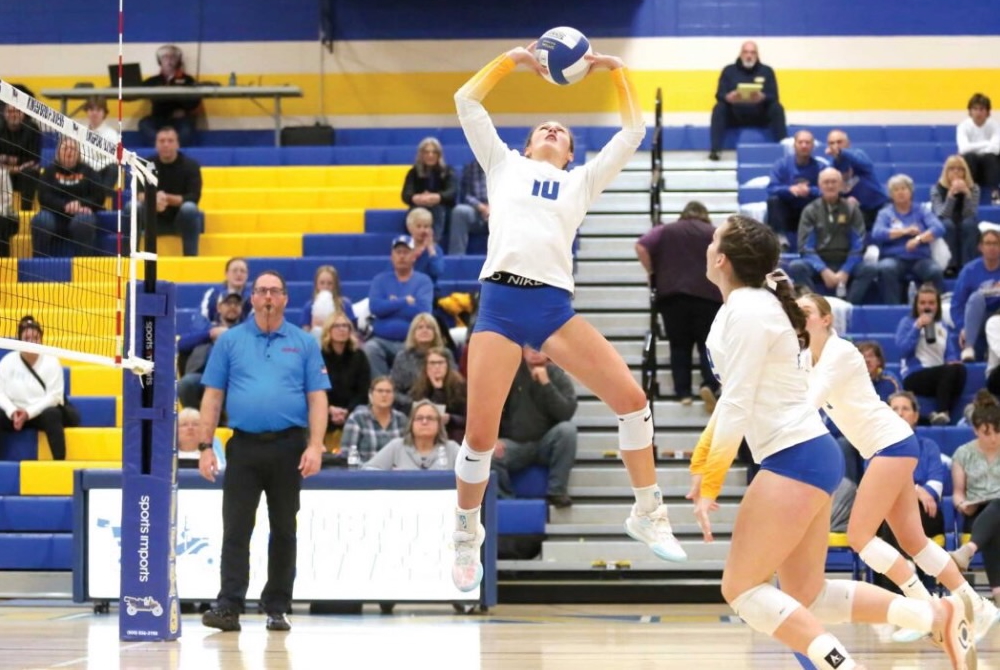
Marquette 4-Peat Full of Milestones
By
John Vrancic
Special for MHSAA.com
May 31, 2014
KINGSFORD — Marquette sophomore Lindsey Rudden on Saturday became the first female athlete to break the five-minute barrier in the Upper Peninsula Track and Field Finals, earning her second straight Division 1 title in 4 minutes, 55.28 seconds.
“At the beginning of the season, this was my goal,” she said. “I had a cheering section here and wanted to do something extraordinary. I can’t thank my parents, teammates and coaches enough. I just feel blessed to have this opportunity and be able to do it.”
She was followed by freshman teammate Amber Huebner at 5:15.25 and Menominee senior Kameron Burmeister (5:17.66) on a sunny and hot day at Flivver Field.
The Marquette girls were crowned champions for the fourth straight year with 145 points. They were followed by Escanaba with 86 and Negaunee with 71.
“The girls took care of business,” said Marquette coach John Peterson. “As coaches we were a little concerned because of the heat. But the girls were very disciplined and stayed under the bleachers until it was nearly time to do their events. Lindsey told me she wanted to break five minutes. We knew it was coming. We just didn’t know it would happen this soon. I told her to take it easy at first and if it felt right, go for it. It was a hot day, but a good day for our team.”
Rudden scratched from the 400 to allow for more recovery time, then retained her 800 title (2:23.54) and helped the winning 1,600 relay.
Huebner captured the 400 (1:00.44) and 3,200 (11:48.8), using a strong final lap to overtake Burmeister (11:54.32), and placed second in the 800 (2:24.12).
“It’s always hard to lead because you can hear the person behind you breathing,” said Huebner. “Plus, Kameron was hurting a little (with a sore hip). I feel bad for her. I just wanted to do my best in the 400. Hopefully, next year I can break a minute. Being my first time here, I was a little nervous. But the upperclassmen helped me through it. The whole team did a real good job. We all did what we had to do. We couldn’t have done it without Coach P.”
Marquette junior Hunter Viitala won the 300 hurdles in a school-record 46.27 seconds and helped the 1,600 relay. She also helped the Redettes place second in the 800 relay and took third in high jump at 4 feet, 10 inches.
“It was cool to see Hunter set the school record in the 300 hurdles,” said Peterson. “We certainly appreciate the efforts of our assistant coach Natalie Messano. She does a nice job with our sprinters and hurdlers.
“I think the U.P. Track FInals are the greatest athletic event in the Upper Peninsula. Getting the opportunity to see so many athletes compete on the same day is phenomenal.”
Escanaba senior Lynsey Collins anchored the winning sprint relays and was runner-up in the 300 hurdles (47.74) and fifth in the 100 (13.59).
Negaunee opened the day by winning the 3,200 relay, and junior Hailee Richards won discus (111-1).
Calumet junior Chelsea Jacques captured the 100 (12.73) and 200 (26.5) and anchored the second-place 400 relay, which finished just two steps behind Escanaba.
PHOTO: Marquette's Lindsey Rudden leads the field during one of her championship runs Saturday at Kingsford.. (Click to see more from RunMichigan.com.)

Kingsford's Kreider Prepared for Next Level After Finishing Stellar Flivvers Career
By
John Vrancic
Special for MHSAA.com
June 19, 2025
KINGSFORD — After completing a successful high school volleyball career, Maddy Kreider is ready to take the next step.
 The Kingsford senior is taking her talents to Michigan Tech, where she’s expected to continue primarily as a setter.
The Kingsford senior is taking her talents to Michigan Tech, where she’s expected to continue primarily as a setter.
“That will be a big step for sure, but it’ll be exciting being with the girls,” she said. “The girls are taller in college. It will definitely be an adjustment, physically and mentally. We’ll be traveling longer distances, and it’ll be a matter of improving the mental part of my game.”
Kreider was selected the Upper Peninsula’s Defensive Player of the Year her final two seasons after the U.P. Sportswriters and Sportscasters Association began voting for all-U.P. volleyball.
“That’s quite an accomplishment,” she said. “It’s a real honor playing with girls I grew up with. We had a great season.”
The 5-foot-8 setter was a four-year starter and two-year team captain at Kingsford, leading the Flivvers to three Division 2 District titles and back-to-back undefeated Great Northern Conference championships. She twice was named GNC Player of the Year.
She was also selected all-state first team in the fall and all-state second team in 2023, and all-region throughout her prep career. Her serving percentage also topped .900 throughout her four seasons on varsity.
 Last fall, the Flivvers reached the Regional Semifinal at Manistique where they dropped a 3-2 decision to Kingsley.
Last fall, the Flivvers reached the Regional Semifinal at Manistique where they dropped a 3-2 decision to Kingsley.
“I thought we’d get through,” Kreider said. “We came out lights out in the first two sets, then it was close in the last three.”
Also among the team’s highlights this past fall was a victory at Calumet, approximately 2½ weeks after dropping a 3-1 decision to the Copper Kings on Kingsford’s home floor.
“We wanted to play them,” Kreider said. “They’re a great bunch of girls to play against. They’ve been the measuring stick up here for many years. Winning on their floor was super exciting. We knew we had to play well just to be competitive. That was a great confidence builder for our group. We were definitely on a high going into the District.”
The Flivvers opened their postseason with a 3-1 triumph over Houghton, then defeated Escanaba in straight sets in the District Final.
Kreider will join Calumet senior Maddie Torola at MTU this fall. Torola, who recorded a season-high 19 kills in the four-set victory at Kingsford, helped the Copper Kings finish 29-5 and reach the Division 3 Regional Final at Sault Ste. Marie where they dropped a 3-2 decision to Traverse City St. Francis.
“It was fun playing against her in high school,” Kreider said. “It will be even more fun playing as teammates. It’ll be exciting to be playing on the same team.”
Both will be playing under new head coach Cindy Pindral at Tech. Both of Kreider’s parents played for the Huskies, her mother (and Kingsford varsity coach) Jaclynn volleyball from 1998-2002 and her father Jason basketball from 1997-2000.
Maddy Kreider recently earned an additional honor when she was selected Female Athlete of the Year for Kingsford’s Class of 2025. She recently completed a solid track & field season for the Flivvers.
At the U.P. Division 1 Finals, Kreider placed fourth in the 100-meter dash (13.2) and anchored the Flivvers to a third-place finish in the 800 relay (1:51.57) and fourth in the 400 (53.03) on their home track.
Kreider was named one of 32 MHSAA/Farm Bureau Insurance Scholar-Athlete Award winners this winter and plans to study exercise science and kinesiology at MTU.
 John Vrancic has covered high school sports in the Upper Peninsula since joining the Escanaba Daily Press staff in 1985. He is known most prominently across the peninsula for his extensive coverage of cross country and track & field that frequently appears in newspapers from the Wisconsin border to Lake Huron. He received the James Trethewey Award for Distinguished Service in 2015 from the Upper Peninsula Sportswriters and Sportscasters Association.
John Vrancic has covered high school sports in the Upper Peninsula since joining the Escanaba Daily Press staff in 1985. He is known most prominently across the peninsula for his extensive coverage of cross country and track & field that frequently appears in newspapers from the Wisconsin border to Lake Huron. He received the James Trethewey Award for Distinguished Service in 2015 from the Upper Peninsula Sportswriters and Sportscasters Association.
PHOTOS (Top) Kingsford’s Maddy Kreider sets for her teammates during a match last season. (Middle) Kreider, right, takes a photo with Kingsford’s Male Athlete of the Year Gavin Grondin. (Photos provided by the Kingsford athletic department.)

